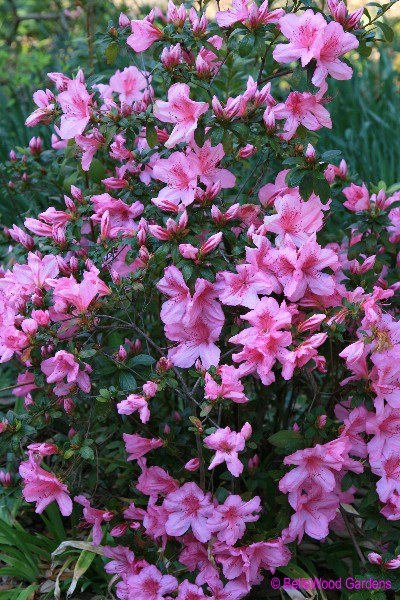
Monday, 9 March 2009
Omnium Gatherum Around Charleston
There are plants indelibly linked with Southern gardens. Bull bay magnolia, Magnolia grandiflora, with its huge and fragrant while flowers in summer, and glossily polished dark evergreen leaves. Live oak, Quercus virginiana, a sturdy wide-spreading tree with small oval evergreen leaves, its branches draped with Spanish moss, a bromeliad that festoons the trees with a scrim of gray. Camellias. Boxwood. Palm trees. Crepe myrtle. The list goes on and on.

Let us not forget azaleas. The large leaved tender azaleas would need
winter shelter to survive in New Jersey, nor would azaleas ever be
in such full bloom in early March. This is, I'm told, just the start of
of Spring's largess. Winter's camellias, the first of flowering cherries
spring azaleas, and soon dogwoods and redbuds will be in bloom.
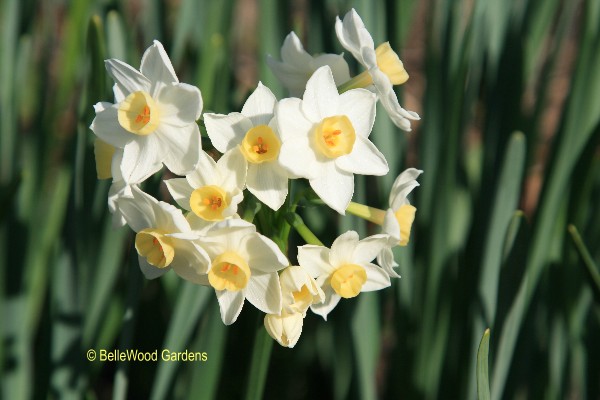
In New Jersey, tazetta daffodils do poorly. The revel in Charleston's heat.
There are plants that grow in my BelleWood Gardens that would fail to thrive in Charleston. They want a certain spell of cold weather to cycle their flowering. There's a minimum period of freezing or below temperatures needed for such vernalization. In California, my brother can have loquats, but not lilacs. Loquats also like Charleston. Typical daffodils, like the standard yellow trumpet 'King Alfred' (or its usual stand-in, 'Dutch Master') do poorly. When Jan, who conducted me through Middleton Place first moved to Charleston many years ago she was told she couldn't grow daffodils. She decided to experiment, and found that many daffodils languish, diminish, and die. While that's true for many, it is not true for all. There are some, like the tazetta pictured above, that quite happily make themselves at home in Charleston. Remember, plants are illiterate. They don't read the books. Experiment, trial different plants, accept your losses and appreciate the successful ones.

Jan's garden has this wonderful 'Peppermint Stick' flowering peach,
an ornamental cultivar of Prunus persica with unusual,
striped red and white, double flowers. The same branch also
sometimes bears all-white or all-red flowers on the same branch.

One of the nurseries I visited on Monday had coontie, Zamia pumila,
at what seemed to me to be a quite reasonable price. But of course,
in New Jersey I only see this as a house plant. Too bad, because
The Floridata web site (for all things horticultural relating to Florida)
recommends coontie for woodland and shade gardens, as a transition plant
near larger specimens, and to create a tropical effect when planted next to
pine trees. Drought tolerant, also useful for xeriscapes and as a low maintenance
ground cover. Great! But I need a cold tolerant version. Doubt Monsanto is interested.
Sweetgrass Basketry
After picking me up at the airport Leslie drove me around, gave me a brief tour of the flavors of Charleston. One highlight was a drive-by of the Old City Market, on Market Street. Originally vendors sold meat, fish and locally grown fresh produce. Today, there's still some local foods (boiled peanuts, anyone?) but there seems to be more shops offering touristy souvenirs. What did fascinate me were the women selling sweetgrass baskets on the street corners.
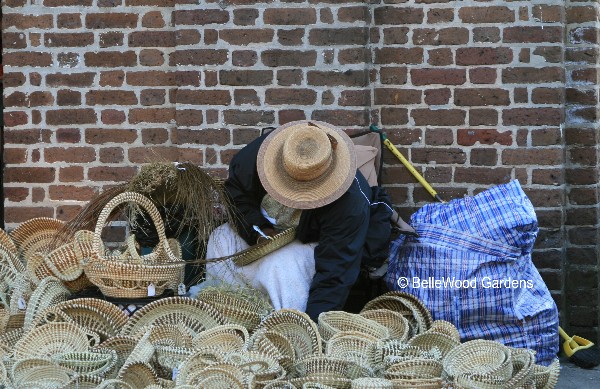
The craft of basket-weaving, passed down from West African slaves,
is considered one of Charleston's most vibrant traditions.
Sweetgrass, Muhlenbergia filipes, grows on secondary coastal dunes
from North Carolina to Texas, about 150 to 250 feet from the mean high tide line.
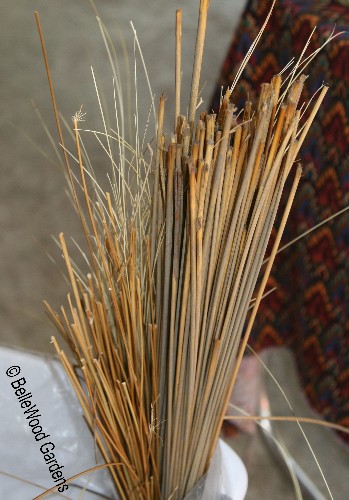
Unlike other types of baskets that are woven, sweetgrass baskets are coiled and stitched.
Each basket starts with a small knot made either of fine-threaded sweetgrass,
or long-leaf pine needles, Pinus palustris. The pine needles may be used
as a contrasting russet color to the yellow-tan of the sweetgrass.

Sometimes another plant is also used. This is the thicker, coarse, black rush,
Juncus roemerianus, locally known as needlegrass, rushel, or bulrush.
It turns a rich tawny color when dried, and, used on the inside of the basket,
also strengthens it. The rows of sweetgrass and / or long-leaf pine needles
are stitched using strips of palm leaf, Sabal palmetto.
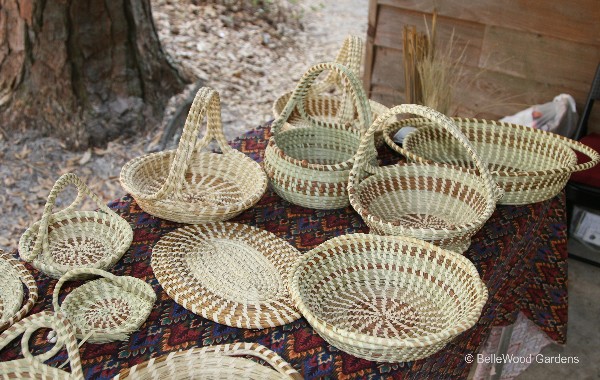
This traditional Gullah craft was once used to create practical farm equipment - to winnow rice, for example. Today's baskets are decorative objects, collected by museums and tourists. The sharply curtailed availability of sweetgrass is presenting challenges threatening the existence of sweetgrass basket making. Beachside habitats in the public domain are protected from disturbance to maintain the dunes and wildlife habitats. Urbanization of the area around Mt. Pleasant has led to the destruction of natural sweetgrass plant communities. And lastly, traditional gathering areas on the Barrier Islands off the coast of Charleston have been developed as beach resorts or private communities with restricted access. Taken together, this means that Charleston's traditional sweetgrass basket makers now have to travel to Georgia and Florida to find adequate supplies.
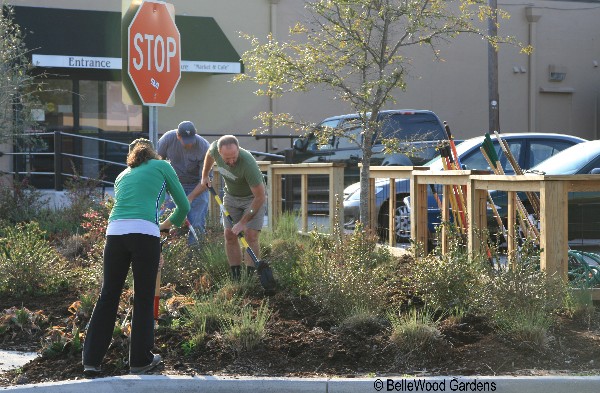
Who are these people digging around in the shopping center planting beds?
They're park angels, volunteers who plant, weed, spread mulch,
keeping Charleston looking good and freeing up the Charleston
Public Works Department to do other things. Anyone can join, and
besides feeling good about what they do, there are Angel U. classes
on gardening and environmental topics, free and only for Park Angels.
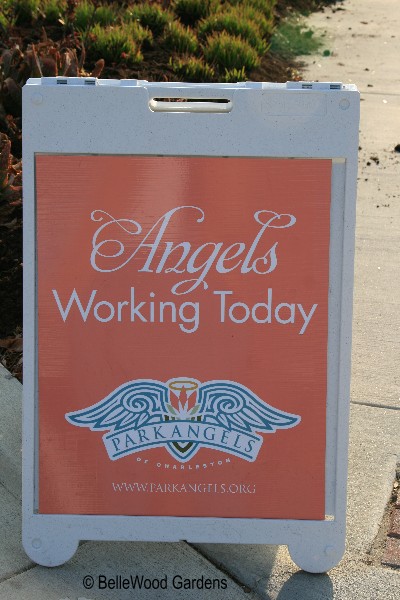
.

"I'll take you out for breakfast on Tuesday, " said Leslie,
"before you fly away home." So off we went to Hominy Grill.
I had eggs and grits and fried green tomatoes.
A wonderful finish to my Charleston journey.

Almost as memorable as this sunset view of the Arthur Ravenel Bridge
over the Cooper River. There I was, a glass of wine in my hand,
sitting on Jackie's deck with her and a couple of her friends
before our foursome went out to dinner. Gracious hospitality
from touchdown to take-off, four great days in Charleston.
Back to March 2009